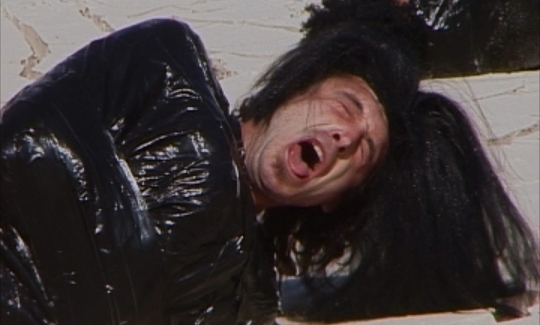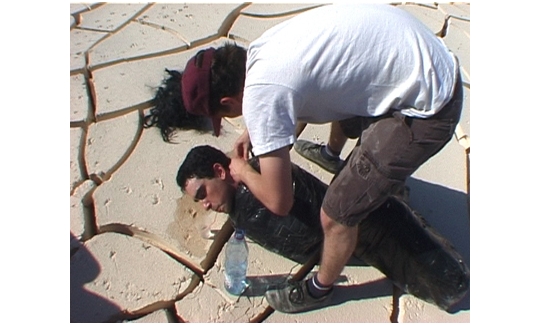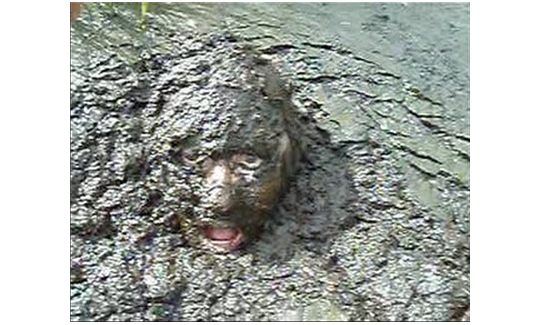Curator: Ilana Tenenbaum
Gilad Ratman's exhibition relates to the concept of the Grotesque and, in particular, to the preliminary etymology of this term. The grotesque originated from the name given to the frescoes uncovered in the 15th century in what was once the personal estate of the Roman emperor Nero. The paintings on the walls and ceiling of the villa depicting fantastic figures were mistakenly dubbed
grotto - meaning a cave, a hidden place - since they were buried in the ground and exposed during excavation works. In this context, the grotesque is fundamentally related to that which occurs underneath, the subterranean and the dimly-lit. Consequently, the interior of the Center for New Media suits the dark scenes and odd images in Ratman's videos. The unusual architecture and the way it stresses the visitor's physical experience echo the films' murky attributes, their irregular structures and the manner in which they excite the viewer's physical experience.
Ratman produces grotesque situations which evolve around struggle, loss and survival. His scenes seem incomprehensible at first and provoke a sense of unrest, eeriness and repulsion. All of these characteristics instill in the spectator a sense of walking through aterra incognita, an unknown territory made up of familiar elements. This is also the space in which the grotesque exists. The backdrop for Ratman's work draws upon the Romantic conception of Man's struggle with the forces of Nature, where he measures himself in relation to the Sublime and the infinite. Ratman's work diverts Romanticism's preoccupation with the Sublime, and redirects it to the grotesque. Similarly, Romanticism is also related to the grotesque, the Sublime's cripple, delinquent twin brother. The expressions of the grotesque situations thus alternate between the wondrous, hideous and ludicrous. The fundamental tension between opposites paves the way for Ratman's use of bipolar mechanisms in the process of constructing his works. He uses fragmentation and repetition, externalization of human emotion side by side with expressions of un-verbal animalism, and other polarities. Ratman also creates the conditions for emotional zeniths or symbolic redemptions without delivering true catharsis. As a result of these tactics, his work sways between an epic, heroic description - and a grotesque parody of it. In addition to the works shown here, the exhibition includes a documentary on the production of one of the videos. In this way its contextual alignment reveals the "backstage" of Ratman's art, and thus echoes the works' internal structure.
Ratman films his works in environments filled with refuse, stale waters and sludge - impure substances that resist clear borderlines and comprehensible categorization. Fragmentation, marginality and an obscure identity exist in his works both in the level of their imagery and their internal structure. The grotesque, the parody and the tragic come together to express a human condition where no vision of order is erected out of the splits and fragments. Through their gaps of information the works demonstrate an experience of disoriented roving and bewilderment. Their grotesque aspects not only report an existence in an evasive world full of contradictions, but also illustrate a particular menacing sensation of loss of orientation. This feeling is common to both the events depicted in the works and the viewer's process of deciphering their meaning. By placing human figures in desperate situations in relation to Earth's crust - a dry and scorched desert, swamps and pools of mud, environments where the materiality of things emerges through the torn, bubbling surfaces and echoes the body's internal and forbidden substances - Ratman brings about an extremely poetic existential moment filled with grace.



